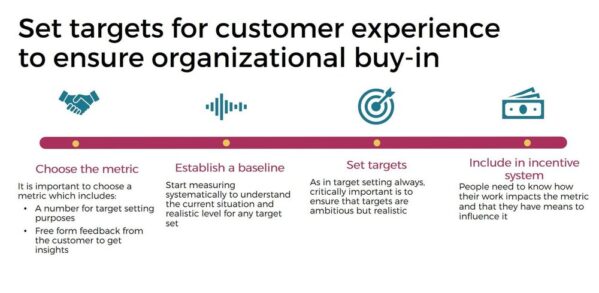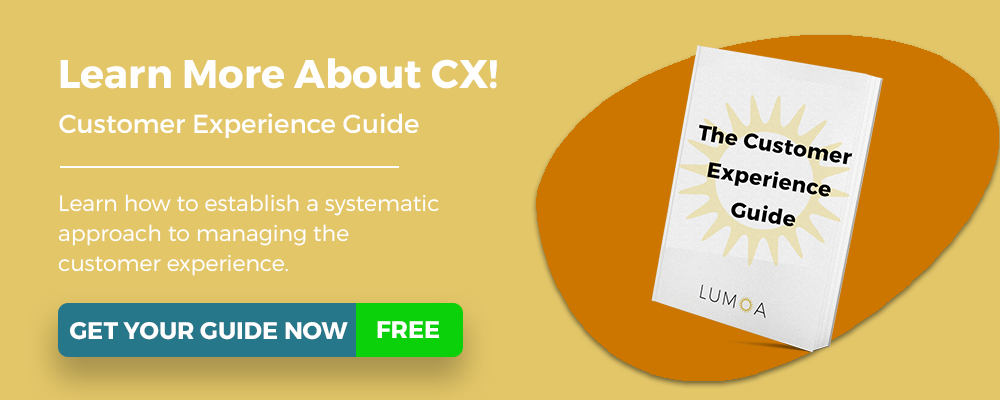Customer Experience Goals: 5 Do’s and Don’ts

Last updated on March 19, 2024
Customer experience goals and targets are critically important if you want to ensure wide buy-in across the organization. If a customer experience metric is followed up at the leadership level, along with the other key performance indicators, mobilization of the rest of the organization becomes significantly easier.
Why is that? Because that tells about the company level commitment and communicates to the rest of the organization that the customer experience really is important to the leadership. Everyone has seen the word “customer” in the center of company strategy slides and values so many times, that unless there are numbers and money tied to it, many people will be considering it as meaningless company jargon.
You are lucky if your employees are not this cynical. But even if they are not, there are significant benefits in setting up a company level customer experience target. The most important benefit is, that a common target encourages people to work across organizational silos and solve the biggest customer problems. The biggest and most persistent problems are typically the ones, that cannot be solved by one function only.

While we have helped companies in establishing company-wide customer experience KPIs and targets, we have learned a few lessons to share with you. Keep these dos and don’ts in mind when planning your customer experience related target setting and incentive system.
When choosing the metric
Don’t
When choosing the metric, don’t just choose a number. While you need to follow the number and establish a target for it, you also need to understand how the organization can influence the target. Therefore, choose a metric which provides you with immediate access to insights on what is driving the metric.
Do
Choose a metric that enables you to analyze the drivers behind the number comprehensively. A good example would be the Net Promoter System (NPS), which includes not only the numerical score but also the free text feedback where the customer is asked why they chose this particular score. Here, integrating an AI text summarizer can be incredibly beneficial. By analyzing the summarized text, you can more efficiently understand the drivers behind the numbers. This synthesized insight is essential when you aim to improve things and achieve your target. An AI text summarizer streamlines the process of digesting large volumes of open-ended feedback, allowing for quicker identification of common themes and concerns, thereby enhancing the effectiveness of the analysis.
When setting the target
Don’t
Don’t just establish a target and after that start measuring. In many cases, there is high pressure to get target setting done already before the measurement even starts. Then you end up googling NPS benchmarks and set the target somewhere (targeting the same level as Apple, anyone?). This method has problems. The public benchmarks are not always trustworthy. There are also significant country and industry-specific differences in NPS levels (and the same applies to other customer experience metrics as well). The moment when you ask the question also influences the result. Health care providers typically get great scores as they happen to ask for feedback just after the patient has received some treatment. Not so easy to repeat if you are in the utility business.
Do
Always first establish a baseline. Plan your approach, start measuring and only establish the target once you know your current level. If you then want to exceed Apple, go for it. But at least now you know, if the difference is 5 or 50 percentage points. The target should always be derived from your own situation: aim to improve, be ambitious but also realistic. Benchmarks can help you to calibrate at this point but as said, they can also be misleading.
When justifying the usage of customer experience metric vs. other metrics
Don’t
Don’t consider the customer experience metric to be something which is inherently in conflict with your revenue or profitability targets. Don’t think it is a soft target which can or will be sacrificed when the money starts to talk.
Do
Using a customer experience metric on leadership level makes sense as a leading indicator. While the leadership mostly cares about revenue and profitability, these metrics seldom tell what is going to be your success next month or next year. They are lagging indicators. But if your NPS is great today and you work on improving it, the chances are you will make good revenue and profit also tomorrow and the day after.
When deciding on incentives
Don’t
Don’t think that customer experience targets are something that only your customer-facing functions, such as sales and customer service, can influence. Most parts of the organization have a role to play here and the ones with an indirect relationship with the customer (such as your product people) are often the ones whose incentivization is the most important thing as they do not necessarily receive direct feedback from customers. Don’t forget that aligned targets can and will help people to work across organizational silos. A common target encourages people to work together. And vice versa, conflicting targets are the fastest way to ruin the customer experience.
Do
When incentivizing people, think all the groups with significant leverage on the customer experience. In some companies, it is everyone. Some companies decide to exclude particular groups, whose direct impact is so small, that they are better incentivized via other metrics. Do what is smart for your company, but ensure wide enough support across the organizational boundaries.
And finally:
When missing the target
Don’t
Don’t freak out even if you don’t reach the target. And especially, do not panic and abandon using the customer experience target if it appears to be hard to achieve.
Do
Analyze what went wrong and move on. If you know what influences your metric, you should be able to set the target realistically and to also achieve it. Remember that Lumoa can help you in getting a clear picture of what the negative and positive drivers of your metric are.
While targets and incentives are not the only solutions to the problem of bad customer experience, they are often critically important for making significant changes in companies with complex organizational setups and established businesses. This applies to most big companies and to many small and mid-sized as well. Therefore they are a great tool to consider for a company of any size.
